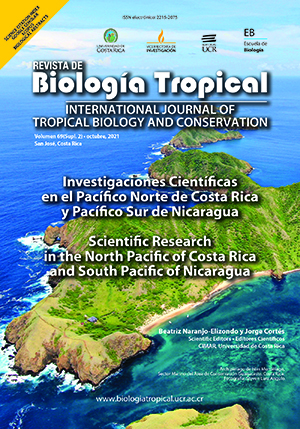Resumen
Introduction: Little is known about the antipatharians in Costa Rica, only three species are known from the Pacific and the occurrence of coral forests was previously reported only for Isla del Coco. Black coral forests were observed at several sites in the north Pacific of the country, within the Guanacaste Conservation Area (ACG), which are reported and characterized in this study.
Objective: To determine the species of black corals present in the ACG Marine Sector and its surroundings, and geographically locate the sites where black coral forests grow.
Methods: Visual censuses were made by diving, samples were taken and analyzed in the laboratory for identification.
Results: These black coral forests are composed of two species: Myriopathes panamensis and Antipathes galapagensis, these species are described and illustrated. The coral forests were found within and outside ACG marine protected areas. Myriopathes panamensis was found between 15-35 m depth and A. galapagensis at 30-45 m. Associated macrofauna was observed among the branches of M. panamensis, their ecological importance and status have not been determined.
Conclusions: The species found did not have morphological variations with those described in other similar regions. Associated fauna was found (mainly the anemone Nemanthus californicus, the bivalve Pteria sterna and the longnose hawkfish Oxycirrhithes typus) and needs to be studied to determine its role on black corals. The importance of the ACG as a marine biodiversity conservation site is emphasized.
Comentarios

Esta obra está bajo una licencia internacional Creative Commons Atribución 4.0.







